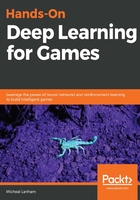
Summary
For this chapter and the last, we took a deep dive into the core elements of deep learning and neural networks. While our review in the last couple chapters was not extensive, it should give you a good base for continuing through the rest of the book. If you had troubles with any of the material in the first two chapters, turn back now and spend more time reviewing the previous material. It is important that you understand the basics of neural network architecture and the use of various specialized layers, as we covered in this chapter (CNN and RNN). Be sure you understand the basics of CNN and how to use it effectively in picking features and what the trade—offs are when using pooling or sub sampling. Also understand the concept of RNN and how and when to use LSTM blocks for predicting or detecting temporal events. Convolutional layers and LSTM blocks are now fundamental components of deep learning, and we will use them in several networks we build going forward.
In the next chapter, we start to build out our sample game for this book and introduce GANs, or generative adversarial networks. We will explore GANs and how they can be used to generate game content.